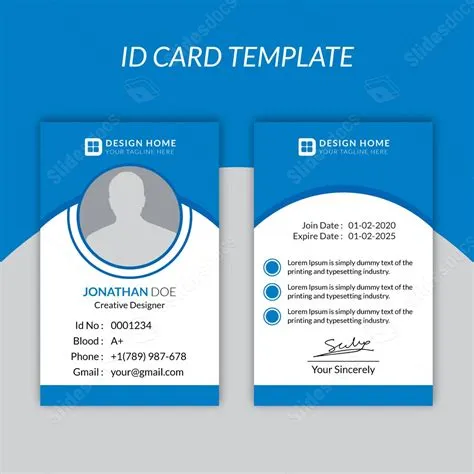Hey there, business owners and design enthusiasts! Ever stopped to think about how much a simple ID card can say about your company? It’s more than just a piece of plastic; it’s a miniature billboard, a brand ambassador, and a security pass all rolled into one. In today’s competitive world, your ID card design needs to be sharp, innovative, and reflective of your brand identity. So, let’s dive into the exciting world of ID card design trends and see how you can elevate your company’s image with a little creativity.
Beyond the Basics: Moving Past the Standard ID Card
Remember those boring, generic ID cards of yesteryear? The ones that looked like they were churned out by a machine, lacking any personality or flair? Thankfully, those days are long gone! Modern ID card design is all about personalization, sophistication, and functionality. We’re talking about cards that are as unique as your business itself. Think of it like this: your logo is your brand’s face; your ID card is its personality. You wouldn’t want a dull, uninspired personality representing your brand, would you?
One of the most significant shifts is the move towards a more personalized approach. Gone are the days of generic templates. Now, we see a rise in cards that reflect the individual roles and departments within an organization. Imagine a healthcare facility, for example, with ID cards that clearly identify nurses, doctors, and administrative staff through subtle yet effective design elements. This not only improves internal recognition but also enhances security and efficiency.
This increased level of customization extends beyond simple visual differences. We’re seeing advancements in the functionality of ID cards, too. Smart cards with embedded chips are becoming increasingly common, offering added security features and the ability to store data such as employee credentials, access levels, or even payment information. For healthcare professionals, this could mean instant access to patient records or secure authentication systems, streamlining workflow and boosting efficiency.
Sustainability: Eco-Friendly ID Card Materials
In today’s environmentally conscious world, sustainability is no longer a luxury—it’s a necessity. This ethos has even seeped into the world of ID card design, and rightfully so. Businesses are increasingly looking for ways to minimize their environmental impact, and that includes choosing eco-friendly materials for their ID cards. Are you considering the environmental footprint of your business cards? You should be!
Fortunately, many manufacturers now offer sustainable alternatives to traditional PVC. These include recycled materials, biodegradable plastics, and even plant-based options. Switching to these environmentally conscious materials not only reduces your carbon footprint but also sends a powerful message to your employees and customers about your commitment to social responsibility. You can learn more about these eco-friendly options by checking out our blog on eco-friendly ID card materials. It’s a small change with a big impact.
Technology Integration: Smart Cards and Beyond
Technology is rapidly changing the landscape of ID card design. Smart cards, with their embedded microchips, are revolutionizing the way businesses manage access control and employee identification. These aren’t just pretty cards; they are versatile tools that boost efficiency and security. Think contactless payments, secure building access, and even biometric authentication—all integrated into a single, convenient ID card. It’s a game-changer!
Beyond smart cards, we are seeing the emergence of digital ID cards and virtual credentials. These offer a flexible and cost-effective solution for businesses that need to manage access to systems and data securely. For instance, healthcare organizations are increasingly adopting virtual ID cards to enhance patient privacy and improve the speed and efficiency of internal communication. These digital trends are transforming industries. You can delve deeper into this topic on our page dedicated to technology-integrated ID cards.
Professional ID Card Designs for Healthcare: A Special Focus
The healthcare industry has specific needs when it comes to ID cards. Security is paramount, and clear identification is essential for both patients and staff. Effective ID cards contribute to a safe and efficient workflow, reducing risks and improving patient care. The design of these cards needs to reflect this critical function.
Consider the need for quick and easy identification in emergency situations. A well-designed healthcare ID card can significantly improve response times and facilitate smoother communication among medical personnel. The information displayed should be clear, concise, and easily readable, even from a distance. This includes details like the employee’s name, job title, department, photo, and any necessary security codes or access permissions.
Furthermore, hygiene is a critical concern in healthcare settings. Therefore, materials used for healthcare ID cards should be easy to clean and disinfect, ensuring optimal hygiene and reducing the risk of cross-contamination. Choosing the right materials is crucial for maintaining a sterile environment, which is central to patient safety. Discover more about appropriate materials and design considerations for healthcare professionals by checking out industry-specific ID card designs and learn how to prioritize sanitation and safety in the design process.
Branding and Aesthetics: Reflecting Your Company’s Identity
Your ID card is more than just a functional tool; it’s a reflection of your brand identity. It’s a small detail that can have a big impact on how your employees and clients perceive your company. It’s a silent brand ambassador. Don’t underestimate the power of a well-designed ID card to communicate your company’s values and professionalism.
The color scheme, font selection, and overall aesthetic should align seamlessly with your brand guidelines. Consistency is key. If your logo uses bold, modern fonts, your ID card should reflect that style. Similarly, if your brand is known for its sleek, minimalist aesthetic, your ID card should convey that same sense of sophistication. For more inspiration and ideas on how to successfully integrate branding into ID cards, explore the different options outlined in our article on modern ID card design ideas.
Customization and Personalization: The Human Touch
In a world increasingly dominated by technology, the human touch remains vital. Personalization adds a unique element to your ID cards, making them more engaging and memorable. It allows you to connect with employees on a more personal level, fostering a sense of belonging and pride within the organization. Think about it: would you rather receive a generic, impersonal card or one that reflects your unique role and contribution to the team?
Consider incorporating elements that go beyond the basics. Adding a personalized message or a small, unique design element can create a more positive and personal experience for employees. This can be as simple as incorporating an employee’s initials or a departmental logo. You can find various examples of customization techniques by clicking this link :customization and personalization in ID card design.
The Future of ID Card Design: What’s Next?
The evolution of ID card design is an ongoing journey, driven by technological advancements and changing business needs. We can expect to see even more innovative features incorporated into ID cards in the coming years. This might include things like enhanced security measures, improved integration with other technologies, and a greater focus on sustainability. The possibilities are truly endless!
We might even see a future where ID cards become even more integrated into our daily lives, acting as a universal key for access to various services and systems. The line between physical and digital IDs may continue to blur, leading to more hybrid solutions that offer the best of both worlds. This is a rapidly evolving field, and we can anticipate more exciting developments in the near future.
Conclusion
Designing an ID card might seem like a small detail, but it’s a powerful tool that speaks volumes about your company. By incorporating innovative trends, prioritizing sustainability, and focusing on both functionality and aesthetics, you can create ID cards that are not only practical and secure but also reflect your brand’s identity and values. Consider it an investment in your brand image and employee morale. Remember, your ID card is more than just a card; it’s a statement. It’s a visual representation of who you are as a company and an important step in enhancing your brand.
FAQs
- What are the most important factors to consider when designing a professional ID card? The most important factors are security, clarity of information, brand consistency, and the choice of eco-friendly materials. Your card needs to be functional, easy to read, and representative of your brand’s values.
- How can I ensure my ID card designs are secure? Consider incorporating features like embedded microchips (smart cards), holographic security elements, and unique employee identification numbers. Also, ensure you work with a reputable ID card supplier.
- What are some sustainable materials for ID cards? Many sustainable options exist, including recycled PVC, biodegradable plastics, and plant-based materials. Research your options and choose materials that align with your company’s commitment to environmental responsibility.
- How can I incorporate my company branding into my ID card designs? Ensure your ID card design uses your company’s logo, colors, and fonts consistently. Maintain a cohesive visual identity across all your branding materials.
- What is the cost of designing and producing custom ID cards? The cost varies greatly depending on the materials, design complexity, and quantity ordered. Get quotes from multiple suppliers to compare prices and find the best value.

